
This feast is observed by Orthodox, Roman Catholics, and some traditional Protestants. Most Protestants ignore Mary’s death because they say it’s not in the Bible. This is true. They also ignore Mary after her death because they say that is not in the Bible. This is false! We’ll come to that later.
Mary’s Death
We Orthodox title this day the Falling Asleep of the Theotokos – or her Dormition (from the Latin) or her Kimissis (Κοίμησις Θεοτόκου) in Greek. “Falling asleep” means death. *
- This term is used several times in the New Testament to refer to death. If we are repentant and in the grace of God, dying is like falling asleep with Christ on this side and waking up with Christ on the other side. After death we will still have a lot of growing to do before we come to perfection, but please don’t believe any of the “scare” theories about what happens. Our God “is good and loves mankind”.
People all over the world honor their departed loved ones. It’s the natural thing to do. I pray for my mother daily. Last week when we were traveling in Ohio my son, grandson and I (it was a guys’ trip) stopped at my parents’ grave and offered Trisagion prayers for them.
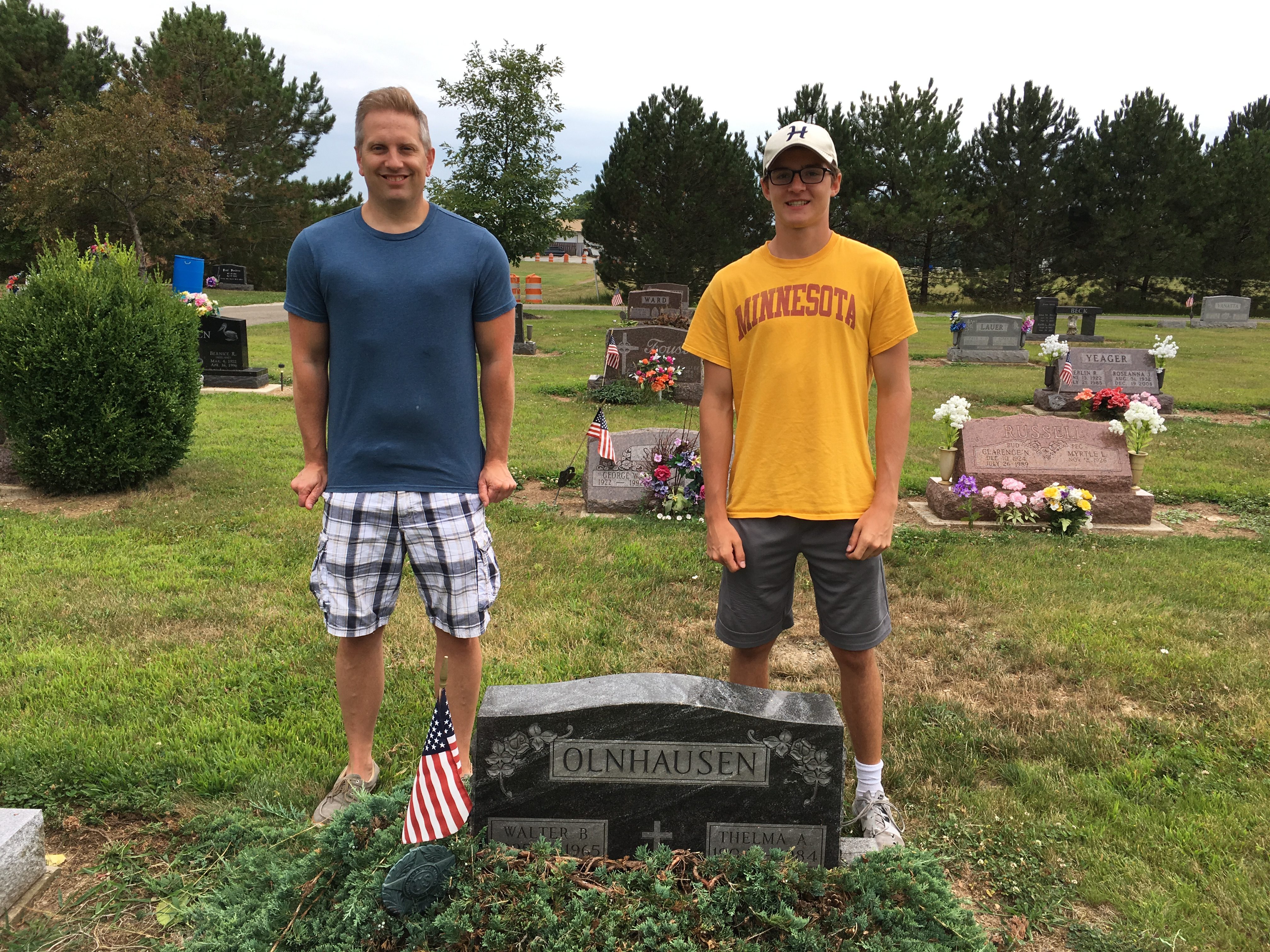 Say hello to my son David and my grandson Matthew.
Say hello to my son David and my grandson Matthew.
I pray for my mom especially on the date of her death, July 25. Did the Virgin Mary really die on August 15? No one knows for sure. But my uneducated guess is that if, 34 years later, I remember the date of my mother’s death, the early Christians likely remembered the date of Mary’s death and passed it down in the Church.
OK, so her death is not recorded in the Bible. But she was there in the very early Church (Acts 1:14), and Christ had given her into the care of the Apostle John the Theologian. How could the early Christians possibly have forgotten her and her death? this Woman who was the Theotokos, the “bearer of God”? who raised and shaped our dear Lord Jesus when he was a boy? this Woman who has become our Mother, too?
Our Mother Mary
I know some folks have an issue with this title, but listen: After being born of the Virgin Mary, Christ then took his new human family and expanded it into the Church. All who are baptized become children of his Father, and brothers and sisters of Jesus, and if you take him you also get his whole family. When my dear son in law married into our family, he didn’t get to pick and choose among us. That’s just the way life is. So on what basis should anyone exclude Mary, our Lord’s Mother? For if we are adopted siblings of Jesus, then we are adopted children of his Mother. Mary is Mother of the whole Christian family, Mother of the Church. What could be more obvious?
![]() When she and his adoptive brothers went out to see if he was taking care of himself, Jesus looked at the crowd and said, “Who are my mother and my brothers? All who do the will of my Father in heaven are my brother and sister and mother.” Matthew 12:46-50 An obvious reference to Mary’s “Be it unto me according to your word.” I remember an old movie which focused on Mary’s face as he said this. Her initial shock (are we being rejected?) slowly turned into a big smile, as she looked out over the crowd, and you could see her realizing: “My family! they’re all my children!”
When she and his adoptive brothers went out to see if he was taking care of himself, Jesus looked at the crowd and said, “Who are my mother and my brothers? All who do the will of my Father in heaven are my brother and sister and mother.” Matthew 12:46-50 An obvious reference to Mary’s “Be it unto me according to your word.” I remember an old movie which focused on Mary’s face as he said this. Her initial shock (are we being rejected?) slowly turned into a big smile, as she looked out over the crowd, and you could see her realizing: “My family! they’re all my children!”
Orthodox genuinely, naturally love our Mother Mary. To forget her and her death seems almost offensive to us – to think of people ignoring Mom!
What happened at her death?
Roman Catholics title this day the Assumption of the Blessed Virgin Mary. They believe that at Mary’s death she 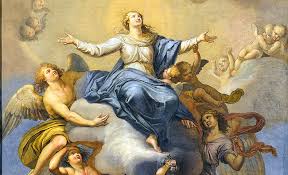 was assumed (“translated”, “moved”) bodily into heaven – although it was not till 1950 (!) that they declared this to be a dogma necessary for salvation. A few Roman Catholics have even believed that the Mother of God did not die. This is the rather sentimental Latin approach. Compare it to the more sober Orthodox icon below.
was assumed (“translated”, “moved”) bodily into heaven – although it was not till 1950 (!) that they declared this to be a dogma necessary for salvation. A few Roman Catholics have even believed that the Mother of God did not die. This is the rather sentimental Latin approach. Compare it to the more sober Orthodox icon below.
Protestants are equally dogmatic. They dogmatically disbelieve in her Assumption. I once visited a Lutheran church which had been given a set of Orthodox icons of the annual feasts. They had them hanging on the walls in the entrance way, for people to see as they went into the church. Good for them! Except for the icon of the Falling Asleep of Mary which showed her Son receiving her soul. I mean, how controversial could that be?! But they offered to give the icon to me “because it isn’t Biblical”. (That again!) Dogmatic disbelief. I almost said, “Neither is Martin Luther”, but I held my tongue. And took the icon.
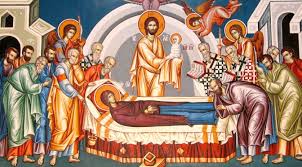 What exactly do Orthodox believe? We are not so dogmatic as either the Roman Catholics or the Protestants. We certainly believe she was “translated”, taken into heaven (“assumed” in that sense) and glorified there, but, as I say, our Dormition icon shows only Christ receiving her soul under the image of a little child. We have no official teaching about her bodily Assumption.
What exactly do Orthodox believe? We are not so dogmatic as either the Roman Catholics or the Protestants. We certainly believe she was “translated”, taken into heaven (“assumed” in that sense) and glorified there, but, as I say, our Dormition icon shows only Christ receiving her soul under the image of a little child. We have no official teaching about her bodily Assumption.
The first written accounts of her funeral and Assumption appear late, in the 5th and 6th centuries, though they are certainly the product of earlier unwritten tradition. (You might want to read the little book On the Dormition of Mary, which is part of the Popular Patristics series available from Saint Vladimir’s Press.) Some of them say that 3 days after her burial her tomb was found empty. At our services, we sing about some of the stories from these accounts: her burial in Gethsemane, how the Apostles were gathered (on the “clouds”) for her funeral, how Thomas was late again, how Bishop Philotheos of Athens was also there and sang beautifully. (I think this last detail is evidence for the authenticity of the account. Why ever would anyone make this up?) But so far as I can find, we do not sing about her being assumed bodily.
This is the Troparion for her Falling Asleep. Since the English text is provided only “mid-video”, I’ll include it here:
“O Theotokos, in giving birth you were preserved in virginity, and in your falling asleep you have not forsaken the world. For since you were the Mother of Life, you were translated into Life. Therefore by your intercessions, deliver our souls from death.”
However, the Theotokos has been fully part of the Church, present all over the world. Some saints seem to concentrate their efforts especially in certain areas or for particular purposes. She has been not only in heaven, but here, doing everything everywhere for everybody, like no other saint. Father Alexander Schmemann wrote an essay called The Presence of Mary, pointing out that if you just hang around the Church for a while you discover for yourself that she is here – like her Son, “more present” on earth universally than she was during her earthly lifetime. We don’t need dogmatic definitions to know that.
It is a Mystery. But…
An Episcopal priest friend of mine once said to me, “I want a straight answer: What do you Orthodox really believe? Was she assumed bodily or wasn’t she? Yes or no.” I answered, “Well… must we have a dogmatic answer? It’s a mystery.” – the typical Orthodox answer when we can’t think what to say. But really, it is a mystery.
However, there are good reasons to believe in Mary’s bodily Assumption:
1 Most Orthodox seem to have believed in it. The people of God matter here. Some Orthodox churches are dedicated to her Assumption, for example the Assumption Greek Orthodox Church in Madison, Wisconsin.
2 There are no relics of Mary. The cult of relics began very early in Christian history – and again naturally so. Bodies are good, created by God. For that reason traditionally, as still in Orthodoxy, Christians have not cremated the dead. In the Judaeo-Christian tradition we have honored the bodies and burial places of our loved ones. Saint Peter’s body lies in honor in Saint Peter’s Basilica in Rome. Saint Paul’s body likewise lies in Saint Paul’s Outside the Walls. Saint Andrew has moved around a great deal, but his head at least is now back in Patras in Greece where he was crucified, and he is honored there. And so on with a multitude of saints, ancient and modern. But there have never been any relics of Mary. If, as tradition says, she was buried in Gethsemane, her relics have never been found there or anywhere else. Would the early Christians, would the Church have just lost her? There must be another explanation for the absence of her relics. The simplest one is that there weren’t any.
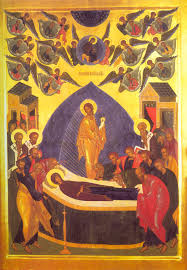 3 It is doctrinally acceptable. There is Old Testament precedent. Elijah/Elias was taken bodily into heaven, and tradition said Moses was too, and probably Enoch. Christ took his risen body with him into heaven at the Ascension. He promised the resurrection of our bodies. We say in the Creed that we “look for the resurrection of the dead.” That means our bodies. Heaven is great enough to take in matter, to receive our bodies. Heaven is not less than physical, it is more than physical. Heaven is super-physical, super-material. In heaven we will be not be less than we are here, but more than we are here. As Blessed Mary already is.
3 It is doctrinally acceptable. There is Old Testament precedent. Elijah/Elias was taken bodily into heaven, and tradition said Moses was too, and probably Enoch. Christ took his risen body with him into heaven at the Ascension. He promised the resurrection of our bodies. We say in the Creed that we “look for the resurrection of the dead.” That means our bodies. Heaven is great enough to take in matter, to receive our bodies. Heaven is not less than physical, it is more than physical. Heaven is super-physical, super-material. In heaven we will be not be less than we are here, but more than we are here. As Blessed Mary already is.
4 Here on earth she has given us so many material signs of her presence. Weeping icons with material “myrrh” – which is just a word for that for which we have no words – flowing from the eyes of innumerable icons. These are not common, but they are far from rare. I have seen 2, maybe 3, myself and I have heard first-hand of many more, and read of far more, all over the world. (We’ll talk about this next week.) Are these material manifestions here signs that she is bodily present on the other side?
The Glorification of Mary
In any event, the Protestants are dead wrong (pardon the expression) about Mary not being in the Bible after her death. She is in the book of Revelation, traditionally ascribed to the Apostle John the Theologian, into whose care the Lord from the Cross gave his Mother Mary: “Woman behold your Son, Son behold your Mother”. Tradition says she lived for a time in Ephesus with John. Some of you may have seen her house there. In Revelation chapter 1 John described a vision of Jesus, “his countenance like the sun shining in full strength”, the risen and ascended Christ. In Revelation 12 John has a similar vision of a “Woman clothed with the sun, with the moon under her feet, on her head a garland of twelve stars” “who bore a male Child who was to rule all the nations”. The “sun” connection between Christ in chapter 1 and the Woman in chapter 12 is 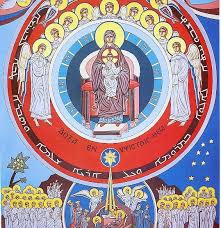 obvious. She shares in his glory. Some say the Woman is Judaism which produced Christ – but, since the Jews had rejected Jesus, would John have meant that? Or perhaps is he referring to the Church as the New Israel, the fulfillment of the Old Israel? Some say the woman is the Church who brings Christ into the world, and that is true. But Biblical stories have more than one layer of meaning. John must certainly have been thinking first about Mary the Mother of God, who literally bore Christ, the Ruler of all nations, Mary whom he knew so well. John is saying that as Christ by nature shines with the light of divinity, so his Mother is now clothed with the light of his divinity, that she has now become by grace what he is by nature, that she is now in heaven in the fullness of being, just as he is. What else can it mean? And as Jesus ascended into heaven, body, mind and soul, his Mother likewise… Dear Protestant brothers and sisters, please read all of the Bible.
obvious. She shares in his glory. Some say the Woman is Judaism which produced Christ – but, since the Jews had rejected Jesus, would John have meant that? Or perhaps is he referring to the Church as the New Israel, the fulfillment of the Old Israel? Some say the woman is the Church who brings Christ into the world, and that is true. But Biblical stories have more than one layer of meaning. John must certainly have been thinking first about Mary the Mother of God, who literally bore Christ, the Ruler of all nations, Mary whom he knew so well. John is saying that as Christ by nature shines with the light of divinity, so his Mother is now clothed with the light of his divinity, that she has now become by grace what he is by nature, that she is now in heaven in the fullness of being, just as he is. What else can it mean? And as Jesus ascended into heaven, body, mind and soul, his Mother likewise… Dear Protestant brothers and sisters, please read all of the Bible.
Orthodox Approaches to the Mystery
Bishop Kallistos Ware writes: “… Orthodox tradition is clear and unwavering in regard to the central point [of the Dormition]: the Holy Virgin underwent, as did her Son, a physical death, but her body – like His – was afterwards raised from the dead and she was taken up into heaven, in her body as well as in her soul. She has passed beyond death and judgement, and lives wholly in the Age to Come. The Resurrection of the Body … has in her case been anticipated and is already an accomplished fact. That does not mean, however, that she is dissociated from the rest of humanity and placed in a wholly different category: for we all hope to share one day in that same glory of the Resurrection of the Body which she enjoys even now.” Festal Menaion [London: Faber and Faber, 1969], p. 64.
However, since we have no dogmatic definition about this, some Orthodox are more cautious and speak only of her Glorification, being careful to reverence the Mystery, as did Orthodox theologian Vladimir Lossky: “The destiny of the Church and world has already been fulfilled, not only in the uncreated person of the Son of God, but also in the created person of his Mother. That is why St. Gregory Palamas calls the Mother of God ‘the boundary between the created and the uncreated.’ Beside the incarnate divine [being] there is a deified human [being]. …In the person of the Mother of God it is possible to see the transition from the holiness of the Old Testament to the holiness of the Church. … we are now concerned with  another transition: the transition from the world of becoming to the eternity of the Eighth Day, the passage from the Church to the Kingdom of God. This last glory of the Mother of God, the eschaton realized in a created person before the end of the resurrection and beyond the Last Judgement. She participates in the glory of her Son, reigns with him, presides at his side over the destinies of the Church in time, and intercedes on behalf of all before him who will come again to judge the living and the dead.” *
another transition: the transition from the world of becoming to the eternity of the Eighth Day, the passage from the Church to the Kingdom of God. This last glory of the Mother of God, the eschaton realized in a created person before the end of the resurrection and beyond the Last Judgement. She participates in the glory of her Son, reigns with him, presides at his side over the destinies of the Church in time, and intercedes on behalf of all before him who will come again to judge the living and the dead.” *
- This quote from Lossky is found in many places, and I know I saw it in one of his books, but I can’t find it now. Does anyone know?
Finally, here is is the lovely Megalynarion for her Falling Asleep, which also implies much, but doesn’t quite say it:
“We bless you in every generation, O only Mother of God. The limits of nature are overcome in you, O most pure Virgin. And in childbirth you remained a virgin, and your death became a herald of life. And after childbirth, you remained a virgin, and after death you are still alive. O holy Theotokos, may you ever save your inheritance.”
Next Week: Weeping Icons
Week after next: On the road again – our 2010 Trip to Greece

Fr Bill
Lossky’s quote may be found in:
Vladimir Lossky
“Panagia”
Chapter 11 of In the Image and Likeness of God (St Vladimir’s Seminary Press: New York, 1974) pp. 195-210
or
online here: http://jbburnett.com/resources/lossky/lossky-image11-panagia.pdf
Thank you very much.
This is absolutely beautiful. Thank you so much!
Thank you Father. This was beautiful. I am a convert from a low church evangelical background. When I was beginning to convert, I thought that prayers to saints and especially the Church teaching on the most Holy Theotokos would be the hardest thing to accept. I was wrong. It is easy and natural.
I think that evangelicals who ignore or even despise Mary do so because they have a low view of the Incarnation. I never heard a protestant sermon on the importance of the Incarnation or the Theotokos in our salvation. They believe Christ became a human being only to endure physical and spiritual pain on the cross. After that, His Humanity is not important at all. It’s almost as if they were unintentional monophysites. To evangelicals, Christ’s humanity can be shed forever without any real effect…like He doesn’t need it anymore to save us. They don’t really teach that God and Humanity are united forever in the Person of Jesus Christ, but only that humanity is more or less become tolerable to God by letting Him vent His anger on His Son instead of us. A real communion does not exist between God and Man in their minds.
Pray for our protestant friends and families. And once again, thank you for the beautiful post. Most Holy Theotokos save us!
What helped me to understand the Theotolos and the saints was to accept them as Family. It would be a very peculiar human family where people talked to and leaned only on the father!
Fr. Bill, I agree with you here. Perhaps Mary played a bigger role in my life (as a mother) as I am willing to admit. Having been raised for many years by catholic nuns in a boarding school, and I remember the month of May was devoted to Mary in special prayers, is etched into my my mind with a little country European Cathedral and kneeling benches, (they used to hurt my knees after a while), but we did pray, or had to, for hours with learned prayers every day in May, though I was not a Catholic.
I was stripped of my birthday and only my names-day was celebrated there. I have bad and good memories of those times of intense religious upbringings and disciplines which helped me later to survive, I admit. I do revere her and hold her in utmost respect, honor and trust, as she trusted her God and her angelic visitations. The piercing of her soul, so that the thoughts of many hearts may be revealed … ?
Fr. Bill ,can you expound on this last sentence and activity and what this means. Is this her redemptive work? Is she a co-worker-redeemer with Christ?
Thank you for this read.
The context for the last sentence in Luke 2:43 is that Simeon “said to Mary His mother, ‘Behold, this Child is destined for the fall and rising of many in Israel, and for a sign which will be spoken against 35 (yes, a sword will pierce through your own soul also), that the thoughts of many hearts may be revealed’.” It refers not directly to Christ’s saving work of redemption but to the effect he will have on Israel and how they will treat him. I think it’s another version of “many who are first will be last, and the last first”. In the course of this, right up to the end on the Cross, Mary’s heart will be broken for many reasons. “Is she a co-worker-redeemer with Christ?” Yes. But so are we all! We are all part of his Body through which he redeems and saves the world. This is our vocation on earth. First among us (after Christ himself) in this work is Mary, which is why we can cry out to her “Most holy Theotokos, save us.”
Thank you Fr. Bill, your answer helped.
Pray for us Oh Holy Theotokos!
Dear Father Bill, Emeritus,
I thank you for another wonderful and holy teaching so beautifully crafted in your blog. I especially enjoy your first person interactions with our fellow protestants, Catholics and Anglican friends. At times, holding our tongue could be argued as good evangelism. In addition, I appreciate your careful selection of quotes, songs, video & cinema and testament. Those elements seem to hone themselves into a wonderful tool for me to better solemnly reflect on the Nature of my personal mission. Ahh, it is often a mystery, eh? You especially aid me in my quiet prayer because I value both your humor and reverence in seeing God’s people and creation.
I will celebrate the coming Falling Asleep of the Theotokos , August 15, in a different frame of mind and heart. I pray for all of us that we will better understand God’s Will and especially honor Mother Mary, those in our own family experience of this world, and as well as the countless saints in Christ.